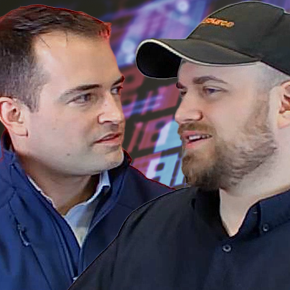February 25, 2025
What Stops Sourcing and Engineering Teams from Achieving ROI together?

Transcript
For manufacturers who want to reduce cost, improve performance, and bring innovative products to market, sourcing and engineering teams should be a match made in heaven. Sourcing can help engineering avoid costly redesigns by sharing what’s possible to make in today’s market, while engineering can help sourcing get a head start in finding the suppliers with the right capabilities to make products at cost and at scale.
But it often doesn’t happen that way. Today we’re discussing what holds back procurement and engineering teams from reaching their full potential together. It’s all about communication in the second of our series of conversations between Spencer Penn, the CEO of LightSource, and aPriori’s Director of Product Marketing, Chris Jeznach.
What Are the Challenges for Procurement and Engineering Working Together?
Chris Jeznach: For procurement professionals and design engineers, there are some challenges to working together as early as possible.
- They’re working in different systems.
- They’re isn’t communication across different departments.
- Procurement might not want engineering to talk to suppliers.
As the CEO of LightSource, what have you seen as the big challenges keeping sourcing and engineering from collaborating as often as they should?
Spencer Penn: Organizational differences, incentive structure differences, and system differences. No offense to SAP, but if you think about a tool like an Ariba, you can barely get category managers to spend any time in there. Forget about getting an engineer to spend any time in there. And so you’re seeing that they’re living in a different world because they’re living in different systems.
There’s also an empathy element too that needs to happen. That is a big blocker.
Engineering will say: Procurement — they’re always losing money, leaving dollars on the table. When we designed this, it was $100. Now look at it, it’s 150. What happened? How did they lose this negotiation?
And then procurement will say: Well, I’m not a magician. When you make a design change when we’ve already chosen a supplier, we’ve already kicked off tooling. Then we only have two options: We can go with the cost up that they’re requesting for us. Or we could scrap the tool and go and put in another 200k or more of CapEx somewhere else, and take in the risk and the changeover.
There can be a really negative way of working where people are finger-pointing. “You changed the design; that’s why we slipped on cost.” “No, you just aren’t effective at negotiating; that’s why we slipped on cost.” It’s not productive, and it comes from a cultural misunderstanding between engineering and procurement.
In some organizations, it’s like one team, one dream. Everybody gets at the same table and understands the challenges that the other half is facing. And they help each other by saying: How can I help partner with you to overcome those challenges?
Chris Jeznach: Sometimes cost is an afterthought for engineers, i.e. I am not going to factor in the cost because maybe that’s not my responsibility or I’m not measured by that. I heard examples where engineering executives says, we’re going to go ahead and bring this product to market and figure out the costs after the fact.
But on the flip side, we’ve spoken to other executives who have said Cost is a focus from the top down. Oe well-known multibillion-dollar consumer goods company said all the way from our CEO down everything is about margin improvement.
What Happens When Should Cost Isn’t Market Price?
Spencer Penn: I’m kind of curious about something that I feel is always the sticking point of should cost modeling, which is what do you do when there’s a gap between the should cost and the market price. This is the big question. If I got five quotes all in a tight pack around 20 bucks, but we ran the should cost and it’s telling us 12 bucks — there’s a gap. Usually, what is the reason for the gap? And then how do you see teams going to try to bridge that gap?
Chris Jeznach: It’s a great question – what causes the gap? Maybe it’s being manufactured in a different region and labor rates are just completely different than the assumptions. It could be material — even if it’s only a different grade of aluminum, that will make a difference in the price. But let’s say it is the same because, ideally, you want to compare apples to apples. Are we procuring it in a different way? Maybe directly from a mill versus through a distribution network. With that comes some economies of scale. We recently added that into our product. We were hearing that companies wanted to be able to assess material pricing if they were to be able to buy it directly from a mill. And when you do that, it can unlock a lot more savings. And so I think when you get those five quotes back from suppliers, and you have in aPriori the detail of what your target cost should be, you can say, “This is what I’m seeing, is this what you’re seeing?”
Maybe that conversation reveals it was being made on a different machine. Maybe they were using a 5 axis versus 3 axis machine and the cycle time is way off. Until you can kind of get the detail it’s really challenging to answer the question of why there’s a gap. But the more you make it a two-way street, the more confidence both of you will have, rather than them just thinking, “You procurement folk, you’re just trying to squeeze out my margin.”
Before I joined aPriori, I worked in a supplier base. I worked at a manufacturer of metal fasteners and engineered fastener components. And I remember we would get from some tier ones, and tier twos, a cost breakdown request. And at times it was a challenging to even get the level of detail they were looking for to fill that in. And often it did feel like we were just trying to squeeze margin out. That’s why you want to see this. When it was approached like a win-win, the more they could explain why they’re doing what they’re doing, the more it showed us this is a two way street and we should work collaboratively together to solve this. If the relationship is always only about just like knocking down this price, we’re butting heads together.
Spencer Penn: I agree with you. And it’s sort of funny. I feel like when you talk to some folks in procurement, you’d think that tier-one suppliers must be like pharmaceutical companies raking in tons of margin. But in reality, these are not insanely profitable businesses. Automotive is a very efficient supply chain. It’s incredible that you can buy a really nice TV that’s like a third of the cost of a whole car. But I think that the thing you’re mentioning is very good. When you get to a supplier and you build a relationship with them where there’s enough trust that both parties are willing to come to the table and say we’re going to have more of an open book relationship, that’s a really amazing thing. The problem is how do you bridge this sort of knowledge action gap where so often what does end up happening is people use their all information to negotiate.
So if you were in procurement or advising someone in procurement, how would you recommend that they approach their suppliers in order to make them feel comfortable with opening up their own tier 2 prices, or sharing real cycle time information, without it feeling like it’s an opportunity for margin extortion.
Chris Jeznach: I don’t have the magic answer to this. It is a really challenging thing to do. But I do think the more that there are collaboration pieces on innovation — maybe there’s an engineering VAVE project where we’re working together and we need your guidance — I think that helps the relationship. I’ve also seen some of our customers do supplier days or supplier weeks where they bring them in and they actually have some suppliers present about the things they’re doing. And that I think opens up that relationship even more. So now they’re more like, let’s work together on how we’re going to improve this.
It can be challenging getting to that level of openness. They might have a directive from their leadership that says in no way are we going to open up and share this information. I lived that myself. But I have found that when you have a tool like aPriori that can look at what I should be paying for this, it can be powerful.
We had an example with a medical device company, where they used aPriori to run millions of dollars of parts through to assess what each of these parts cost, and one phone call to one supplier in minutes was six-figure savings. They said, look, we’ve done this analysis, we’ve reviewed this, and something seems out of whack here. And they compared it to the other parts that the supplier was making and said, comparatively, this one doesn’t seem right. And when that supplier saw that, they looked in the detail, they said “You’re right.” So it can happen, but without a tool that can get into the detail to show you that, it’s really tough to do. If you’re just calling a supplier and saying, “Hey, I think this should be lower,” it’s not really going to go anywhere.








